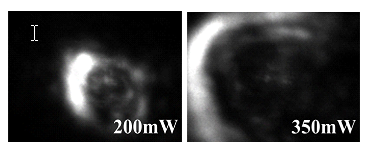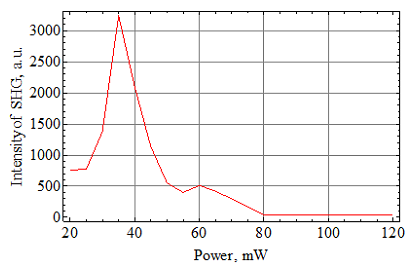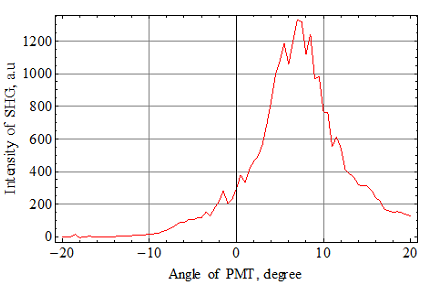1. Lomonosov Moscow State University, Russia, Faculty of Physics
2. Russia, Moscow Institute of Radio Equipment, Electronics and Automation
«Poster report»
OF THE REPORT:
O.V.Samotokhin, A.K.Bolotov
Oleg Samotokhin
Study of the photo-induced optical inhomogeneity effect in a ferroelectric Sn2P2S6 crystal pumped by a femtosecond laser
Study of new properties of materials related to ferroelectric semiconductors is nowadays a field of actual research. It is contributing the development of methods, that control ferroelectric domain structure by using ultrashort laser pulses. Properties of induced optical inhomogeneity can be used in schemes of optical signal control in the modern physical equipment.
Sn2P2S6 crystal is a ferroelectric-semiconductor, which undergoes a second-order phase transition to a centrosymmetric paraelectric phase at a temperature near 338 K [1]. Crystal has a high nonlinear optical [2] and electro-optic coefficients [3]. Photorefractive effects in the crystal Sn2P2S6 has been studied quite well [4,5,6]. At the same time, analysis of the crystal domain structure using effects of laser radiation scattering presents a special interest. In our experiment, we have compared two methods - the study of scattered radiation at the pump frequency and the same study at the second harmonic (SH) frequency generated in the crystal during the pump illumination. We used Ti:Sapphire laser as a pump source with the wavelength of 800 nm and a pulse duration of 100 fs.
Applying the linear scattering method, we have observed changes in the distribution of the intensity of the pump-frequency radiation for three values of the incident power. Increasing excitation intensity leads to increase of the scattering region. It may indicate the inducing of optical heterogeneity by laser irradiation of the Sn2P2S6 crystal (Fig.1).

Fig.1: Intensity distributions of the pump first harmonic after passing through a Sn2P2S6 crystal for three values of the pump power.
We have investigated dependence of intensity of the second harmonic generation (SHG) at the output of the Sn2P2S6 crystal on the power of the incident pump radiation within the non-linear scattering method. The region of anomalous SHG intensity dependence was observed around an average incident power of 35 mW (Fig. 2.).

Fig.2: Dependence of the SHG intensity at the output of the crystal Sn2P2S6 on the average power of the pulsed pump radiation.
We have also studied dependence of the SHG intensity on direction of the SH propagation (Fig.3.). Optical SH signal was detected by a photomultiple tube operating in a photon counter mode that was oriented at different angles relatively to the pump direction. The non-monotonic behaviour of the intensity distribution was observed, which had maximum at the angle near 8 degrees with respect to the incident pump direction.

Fig.3: Angular distribution of intensity of the SHG radiation transmitted through a Sn2P2S6 crystal (recorded at a pump power of 65 mW).
The spatial intensity distributions were measured for the linearly scattered pump radiation at different temperatures of the crystal. Under constant values of the pump power we heated the crystal to the temperatures above the phase transition. There was observed a significant change in the pattern of radiation scattered in a crystal.
All the experimentally observed dependences indicate significant exposure of optical femtosecond pulses on the structure of optical inhomogeneity of a Sn2P2S6 crystal in the ferroelectric phase.
C. D. Carpentier and R. Nitsche, “Vapour growth and crystal data of the thio(seleno)-hypodiphosphates Sn2P2S6, Sn2P2Se6 , Pb2P2S6 , Pb2P2Se6and their mixed crystals,” Materials Research Bulletin 9(4), 401–10 (1974).
• D. Haertle, M. Jazbinˇsek, G. Montemezzani and P. G¨unter, “Nonlinear opticalcoefficients and phase-matching conditions in Sn2P2S6”, Optics Express 13, 3765 (2005).
• D. Haertle, M. Jazbinˇsek, G. Montemezzani and P. G¨unter, “Nonlinear opticalcoefficients and phase-matching conditions in Sn2P2S6”, Optics Express 13, 3765 (2005).
• D. Haertle, M. Jazbinˇsek, G. Montemezzani and P. G¨unter, “Nonlinear opticalcoefficients and phase-matching conditions in Sn2P2S6”, Optics Express 13, 3765 (2005).
• D. Haertle, G. Caimi, A. Haldi, G. Montemezzani, P. G¨unter, A. A. Grabar, I. M. Stoika and Yu. M. Vysochanskii, “Electro-optical properties of Sn2P2S6”, Optics Communications 215, 333–43 (2003)
• A. A. Grabar, R. I. Muzhikash, A. D. Kostyuk, and Y. M. Vysochanskii, “Investigationof the switching processes in the domain structure of ferroelectric Sn2P2S6 by the dynamic holography method,” Soviet Physics Solid State 33(8),1314–16 Translated from Fizika–Tverdogo–Tela. vol.33, no.8; Aug. 1991; 2335–9 (1991).
• S. G. Odoulov, A. N. Shumelyuk, U. Hellwig, R. A. Rupp, A. A. Grabar, and I.M. Stoyka, “Photorefraction in tin hypothiodiphosphate in the near infrared,”Journal of the Optical Society of America B (Optical Physics) 13(10), 2352–60 (1996).
• A. A. Grabar, I. V. Kedyk, M. I. Gurzan, I. M. Stoika, A. A. Molnar, and Y.M. Vysochanskii, “Enhanced photorefractive properties of modified Sn2P2S6,”Optics Communications 188(1-4), 187–94 (2001).